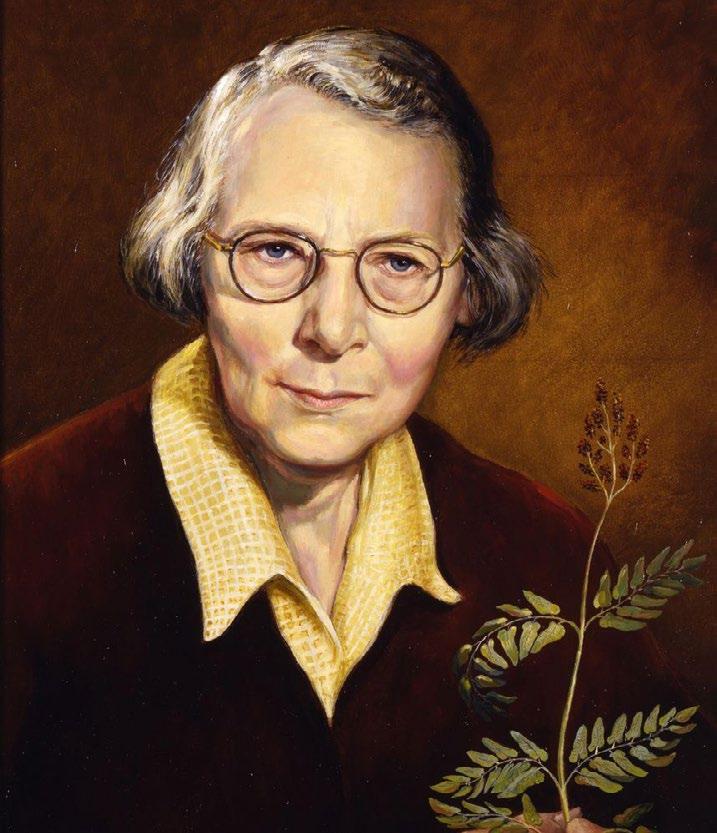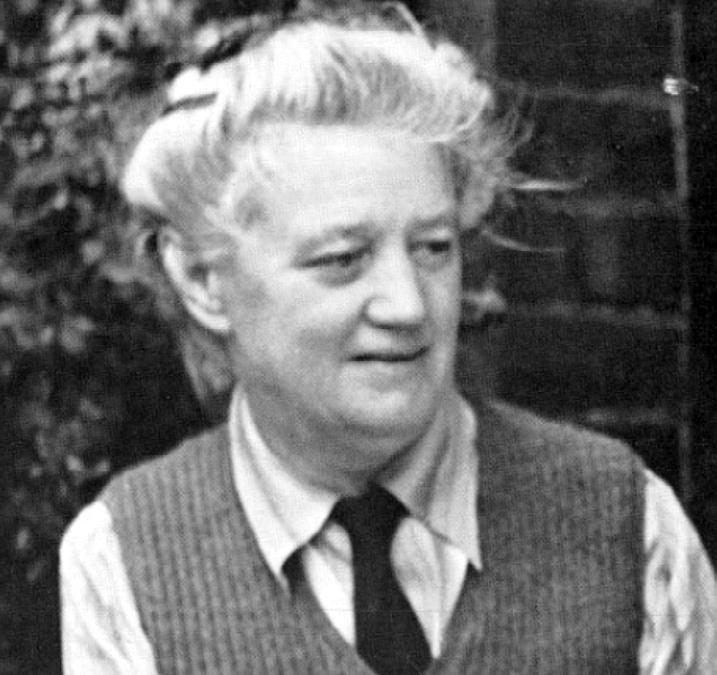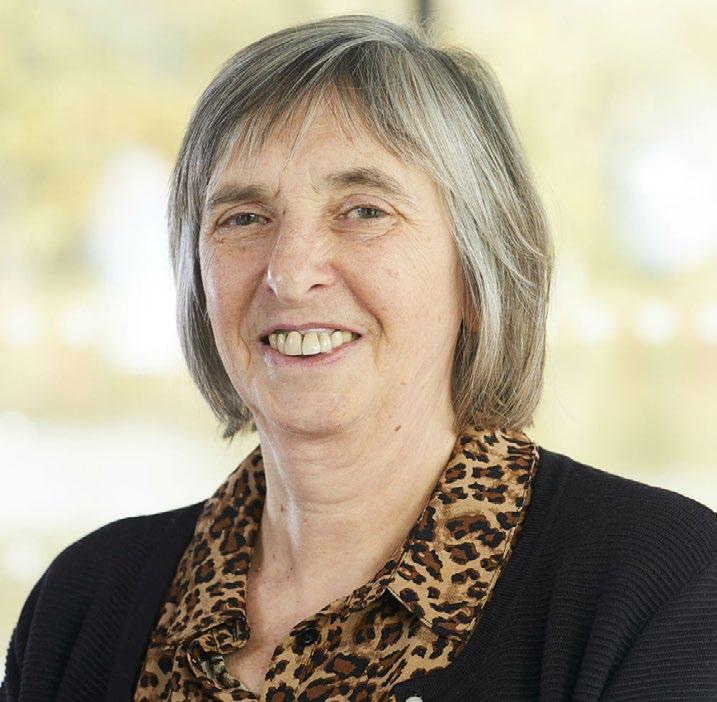
6 minute read
WOMEN WHO HAVE SHAPED THE SEB
BY REBECCA ELLERINGTON
The SEB has played a significant role in shaping the field of experimental biology over the past century. While the contributions of many notable male scientists to the SEB are well documented, the pivotal role played by women in the Society’s development and success are sometimes overlooked.
In this article, we will explore the lives, research and contributions of some of the pioneering women who have helped to shape the SEB, from the early days of the Society’s formation to the present day.
Marie Victorie Lebour, a British marine biologist born in 1876, made significant contributions to the study of marine life in the early 20th century. Her pioneering work in the field of marine biology helped to lay the groundwork for modern oceanography. Born in Northumberland, England, Marie was the youngest of three daughters in a family with an appreciation for nature. Her father, George Lebour, was an accomplished artist and prominent geologist. Growing up, Marie cultivated an interest for the natural world while accompanying her father on his geological excursions, ultimately inspiring her own career.
After initially studying art, Marie began working at Durham University as a demonstrator in the Department of Zoology from 1906 to 1909. During this time, she pursued her BSc and MSc in Zoology and later became a lecturer at the University of Leeds while earning her doctorate. Even before receiving her formal education, Marie had already begun her research career, publishing her first paper in 1900 on land and freshwater molluscs.
Following her doctorate, Marie worked at the Marine Biological Association in Plymouth, England, where she remained for her entire career studying
Blackburn and palaeobotanist Dr Hamshaw Thomas, who recommended Professor Otto Rosenberg’s laboratory in Stockholm, Sweden. There, Irene began her early work using chromosome number to elucidate interrelationships between plants and their phylogeny.

CHRISTINE RAINES (–PRESENT)
the ecology and physiology of marine animals. She focused primarily on marine invertebrates, microplankton, crustaceans and molluscs and made several significant discoveries, identifying 28 new species of microplankton and helping to establish the importance of plankton in the marine ecosystem. Her background in art proved useful, and she created illustrations and watercolours for her research publications.
In addition to her research, Marie was also an active member of the scientific community. She was amongst the first cohort of scientists who joined the SEB in 1923 to collaborate and exchange ideas. Her involvement in the SEB helped to further establish her reputation as a leading figure in the field of marine biology.
Marie passed away on 4 March 1974, yet her legacy in the field of marine biology continues to be felt today. Her contributions have helped shape our understanding of the oceans and the delicate balance of life that exists within them. She was a trailblazer in a field dominated by men and is an inspiration to aspiring marine biologists around the world.
IRENE MANTON (1904–1988)
Irene Manton was a British cytologist who was born in London. Her father, a dental surgeon, introduced her to a microscope, and her mother encouraged her and her sister to take an active interest in natural history. At school, Irene developed a passion for and, despite the staff considering her idle and encouraging her parents to remove her from school to pursue music, she passed the school-leaving examination with ease, winning a Clothworkers Scholarship to Cambridge to study Botany.
After reading the work of Edmund Beecher Wilson, Irene decided she wanted to pursue a career in plant chromosome cytology. In order to achieve this goal, Irene sought advice from cytologist Dr Kathleen
In 1929, Irene joined the Botany Department at the University of Manchester as Assistant Lecturer. She worked under the supervision of Professor W.H. Lang, who instilled in her the importance of recording microscopic observations through photography and using fresh plant material. Lang encouraged her to switch her research focus to ferns, a subject she would continue to study for the rest of her career. She later developed the “squash method”, which allowed for more accurate chromosome counting in ferns, and helped to establish that accurate chromosome counting is vital for characterising species and for phylogenetic classification.
Irene was not only a brilliant scientist, but also a generous contributor to the scientific community. She was deeply involved with the SEB, serving on the Council during the 1950s and presenting at numerous SEB conferences. Beyond her research and service to the SEB, Irene was a gifted mentor and educator, inspiring and training young plant biologists. Her enthusiasm, meticulous attention to detail and contagious energy left a lasting impact on generations of postgraduate students.
Apart from her scientific career, Irene had a wide range of artistic interests. She was passionate about music and played the violin to a high standard and collected Chinese and modern art. Irene continued to pursue both her leisure and scientific pursuits into her retirement before passing away on 13 May 1988.
Irene’s legacy in the field of plant biology and as an advocate for young biologists is honoured by The Irene Manton Poster Prize, awarded annually to the best poster presentation by a young scientist at the SEB’s Annual Conference.

Christine Raines, a British plant biologist who has made significant contributions to the field of plant science, is best known for her research on the molecular mechanisms of photosynthesis and has been widely recognised for her work.

Christine studied for her undergraduate degree in Plant Biology at the University of Glasgow, where she also received her PhD with a thesis on photosynthesis. She then joined the molecular laboratory at the Plant Breeding Institute in Cambridge as a postdoctoral researcher and later joined the faculty at the University of Essex, where she continues to work as Professor of Plant Molecular Biology. Christine has established herself as a leader in her field of research, which has focused primarily on the molecular mechanisms of photosynthesis, with an emphasis on understanding how plants can be optimised for greater efficiency and productivity. She has also investigated how plants respond to environmental stress and how they can be genetically engineered to produce more biomass.
One of Christine’s most notable scientific contributions has been her work on the Calvin cycle. She and her team discovered that the enzyme SBPase plays a critical role in controlling CO2 assimilation in tobacco plants. By increasing the expression of this enzyme, they were able to increase the photosynthetic capacity and yield of transgenic tobacco plants. This finding has important implications for the agricultural industry because it has the potential to significantly increase crop yields, a vital aspect in combating food insecurity.
Christine’s contributions to the scientific community go beyond her research work. In 2017 she became the first female president of the SEB, during which time she worked to increase the participation of women in science and to promote diversity and inclusion in the field. On her appointment, Christine commented “women have played a significant role in our sections and in our council, and therefore it seems only appropriate that we would have a female President”. Her leadership encouraged SEB’s tradition of providing opportunities for young scientists to present their research and network with their more experienced peers, ensuring there was no separation between professors, students and postdocs within the Society and its meetings. Reflecting on her belief she stated “we are all one big community”. In addition to her leadership roles in the SEB Council, Christine also contributed to the history of the SEB journals, serving as the first female Editor-in-Chief of the Journal of Experimental Botany. Under her editorship, the journal published novel research on topics such as the genetic engineering of plants and the regulation of photosynthesis.
Christine continues to be an influential figure in the field of plant science and her contributions to the field and the SEB have been invaluable.
The SEB owes much of its success to the pioneering women who have contributed to the Society and the field of experimental biology. Marie Lebour, Irene Manton and Christine Raines are just a few of the inspiring women who dedicated their careers to advancing this field, paving the way for future generations of scientists. Through their groundbreaking work, these women have left an indelible mark on the SEB and the wider scientific community. If you’re interested in learning more about the other women who have shaped the SEB over the past century, you can find an in-depth article on the SEB website under the centenary section.
Bibliography
Marie Lebour
• Ogilvie MB, Harvey JD. The Biographical Dictionary of Women in Science: Pioneering Lives from Ancient Times to the Mid-20th Century. Routledge, 2000, p745–746.
• Shannen. Half-hidden Histories: Marie Lebour. 21 May 2020. https://storieswithshannen.wordpress. com/2020/05/21/half-hidden-histories-marie-lebour/
• Watts M. Marie V. Lebour 1904-1971. J Mar Biol Assoc UK 1975; 55: 403–410.
Irene Manton
• Leadbeater B. Irene Manton: a biography (1904–1988). The Linnean 2004; Special Issue 5.
• Preston RD. Irene Manton. 17 April 1904–13 May 1988. Biographical Memoirs of Fellows of the Royal Society 1990; 35: 247–261.
Christine Raines
• Professor Christine Raines becomes SEB President. SEB News. 6 January 2017. https://www.sebiology. org/resource/professor-christine-raines-becomesseb-president.html
• Raines C. Letter from the President. SEB Magazine 2017, Autumn, p4–5. https://www.sebiology. org/news-publications/magazine/autumnmagazine-2017.html
• University of Essex Faculty of Science and Health. Professor Christine Raines [faculty page]. https://www. essex.ac.uk/people/RAINE84508/christine-raines










